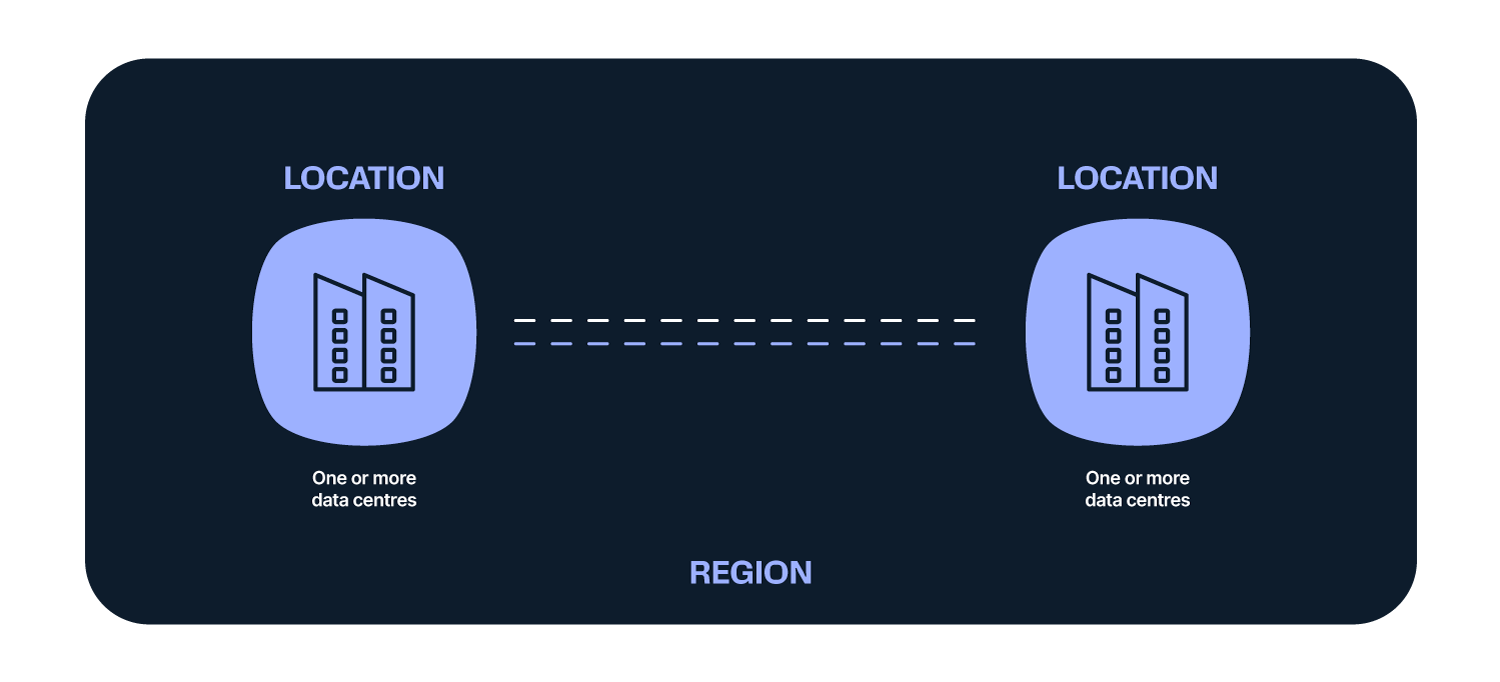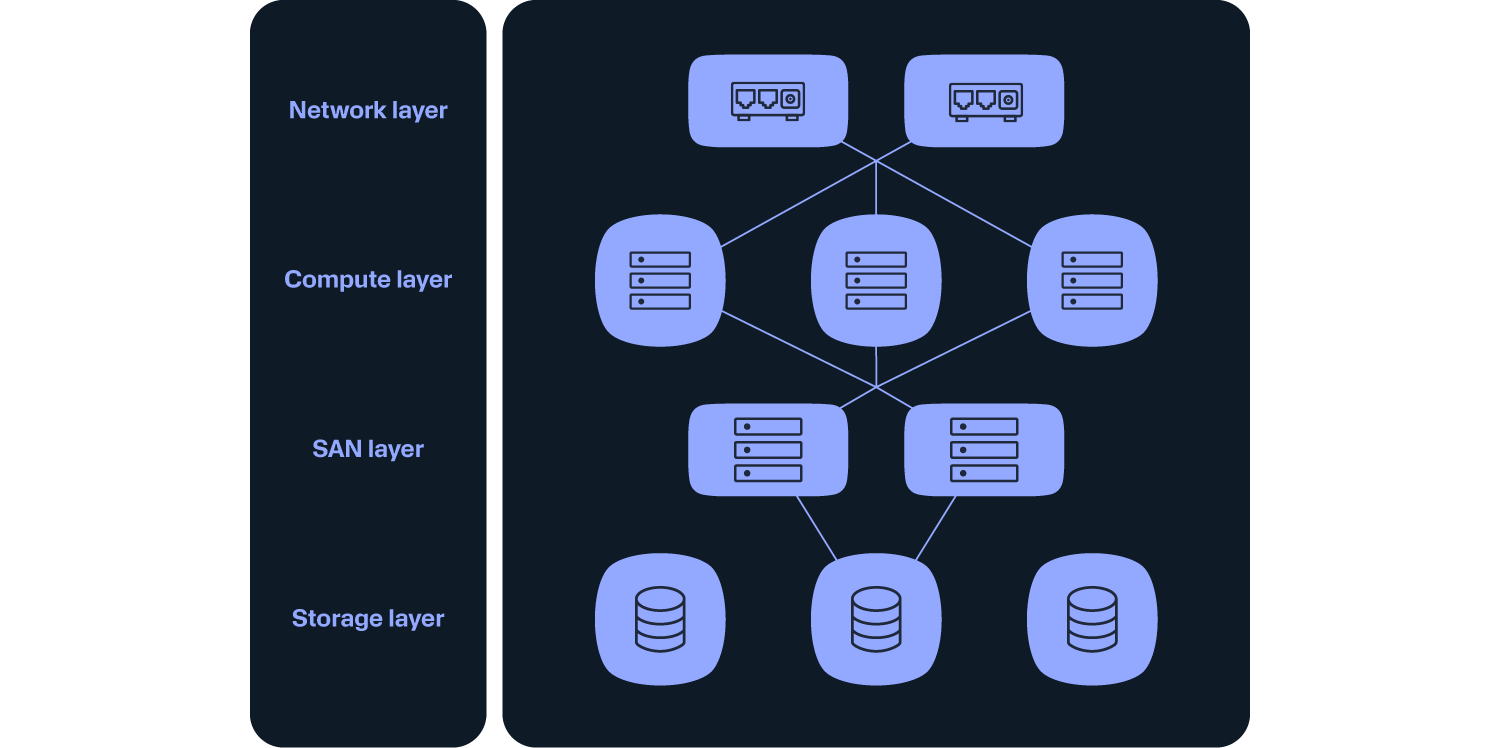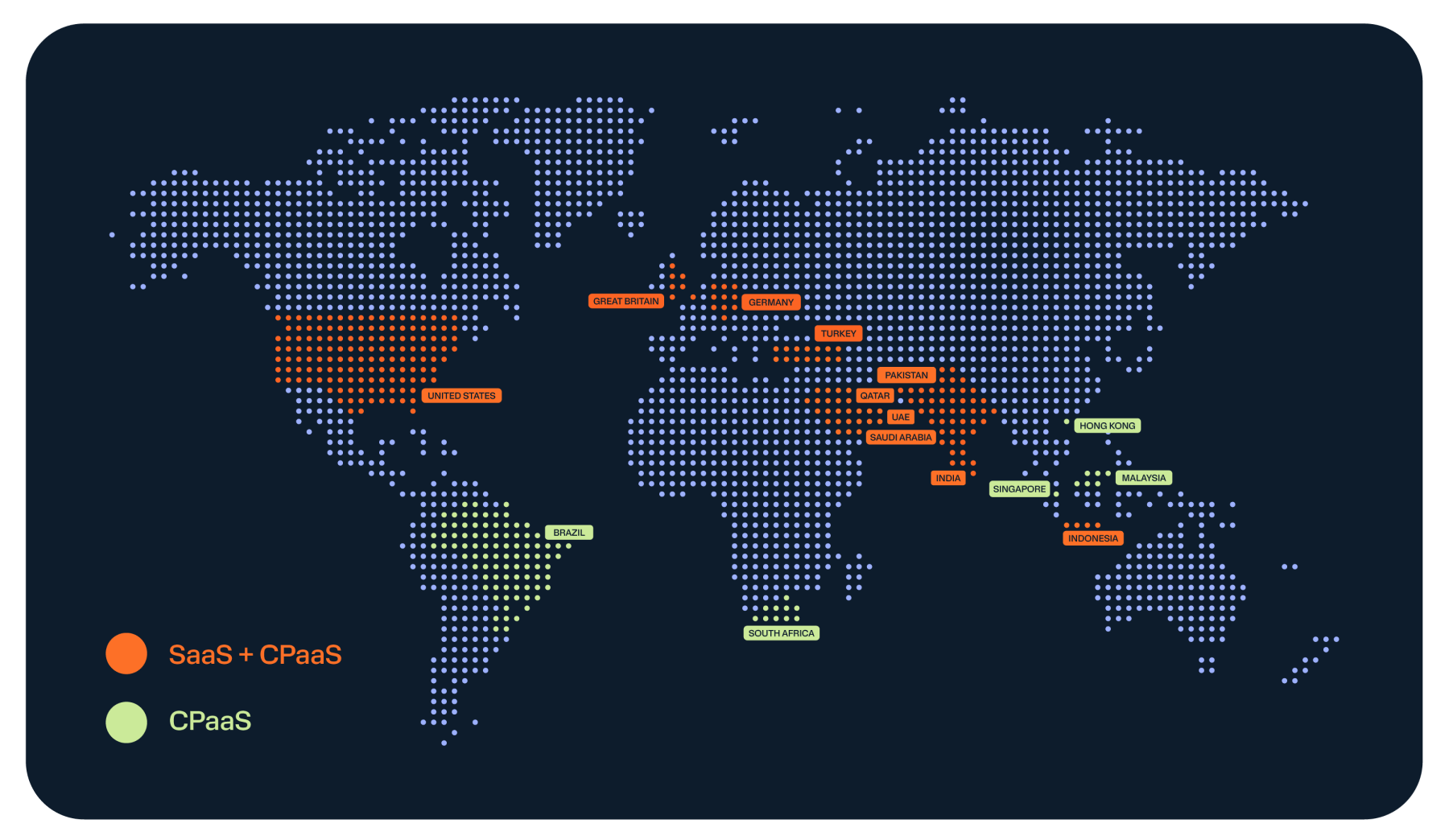Infrastructure overview

Key terms
As we explore the complexities of Infobip services and infrastructure, it is crucial to understand several key terms and definitions. These concepts, such as Infobip services, location, data center, region, and availability zones, form the backbone of our operations and are crucial to understanding how we deliver seamless communication solutions to businesses worldwide.
The following sections provide a comprehensive understanding of our key terms, services, and how we use our global infrastructure to ensure the best possible experience for our users, regardless of their location.
Location
Location is a logical construct that combines software components to create products used by customers. The strategic distribution of these locations across the globe is intended to optimize customer connectivity and minimize latency. This means that Infobip strategically places its infrastructure in different geographical areas to enhance the accessibility and performance of its services around the world. To ensure robustness and continuity of service, each Infobip location is equipped with availability zones. These zones are specifically designed to maintain high availability. Creating a new location typically occurs when a new data center is deployed, unless the new data center serves as an extension to an existing location.
Data center
Data center is a distinct physical facility, often comprising one or more buildings, specifically designed to house and manage computer systems and digital infrastructure. It is a facility equipped with its own power sources, cooling systems, and advanced networking infrastructure, and has stringent physical security measures in place. This dedicated setup ensures that the data center can operate independently, maintain optimal temperatures for its hardware, facilitate efficient communication between components, and safeguard against unauthorized access. With this, it collectively contributes to a reliable and secure environment for digital operations.
Infrastructure region
Infrastructure region refers to a grouping of selected locations organized into a cohesive and logical unit within a specific geopolitical area. To establish a region, a minimum of two interconnected and redundant locations is necessary. This design ensures that there is resilience and backup capabilities in place, enhancing the reliability and availability of the products hosted in that region.
Regions are determined based on the headquarters or geographical location of the clients. This approach allows for a tailored and client-centric organization of data centers, aligning with the specific needs and preferences of individual clients. By associating regions with client headquarters, a more customized and geographically relevant infrastructure is offered to better support clients' operations and data processing requirements.
Availability zones
Availability zones (AZs) act like the building blocks of a data center, each serving as a small, independent unit with a crucial mission: ensuring high availability. They can be described like the smallest logical sections inside a data center, and their primary goal is to keep things up and running smoothly.
If, for some reason, one zone faces a problem or goes offline, the other zones step up to take over. They work together to support regional services, maintain overall capacity, and keep a high level of availability. Each AZ is made of real, tangible hardware components like racks, power systems, servers, storage units, and top-of-the-rack switches.

Region connectivity
In the Infobip network architecture, the connectivity between data centers is meticulously designed to ensure optimal performance, reliability, and resilience. The main component of this connectivity strategy are the primary private Layer 2 links that form the backbone of our inter-data center communication.
Private Layer 2 links
The private Layer 2 links serve as the cornerstone for connecting our data centers, providing a dedicated and efficient channel for the exchange of data. This approach offers several key advantages:
- Enhanced speed and efficiency: Private Layer 2 links offer a direct and swift communication pathway between data centers. By eliminating the detours often associated with public connections, we achieve lower latency and faster data transfers.
- Independence from internet hurdles: Unlike public connections, our private Layer 2 links operate independently of external internet issues. Rerouting problems, ISP disruptions, and other internet-related challenges do not impact the reliability of these connections, ensuring continuous and uninterrupted data flow.
- Isolation from external traffic: The private Layer 2 links provide a dedicated and isolated channel exclusive to our network. This isolation minimizes the risks associated with external internet traffic, safeguarding the integrity and security of our data transmissions.
Redundant public connections
While private Layer 2 links serve as the primary backbone, we enhance this robust infrastructure with redundant public connections. This dual-connectivity strategy adds an extra layer of resilience to our network:
- Increased fault tolerance: Redundant public connections act as failover mechanisms, ensuring continuous connectivity even in the face of unexpected disruptions or hardware failures. This redundancy mitigates the impact of unforeseen events, providing a safety net for our critical data pathways.
- Geo-diversity for disaster recovery: Public connections, strategically distributed and diverse, contribute to our disaster recovery strategy. In the event of a data center outage, these redundant connections enable seamless failover to alternative locations, minimizing downtime and maintaining operational continuity.
In summary, our region's connectivity architecture leverages the strength of private Layer 2 links as the primary means for fast and reliable data exchange between data centers. By coupling this with redundant public connections, we fortify our network against unforeseen challenges, ensuring a robust, high-performance, and resilient inter-data center communication framework.
Automated rerouting for uninterrupted connectivity
We have implemented a sophisticated Auto Rerouting system to ensure seamless and resilient network operations. This system is designed to quickly address any packet loss over our links, whether they are Layer 2 or public connections, interconnecting our data centers.
Key features
- Dynamic response to packet loss: The Auto Rerouting system is engineered to actively monitor the health of our network links. In the event of packet loss detection, whether on our Layer 2 links or public connections, the system initiates an automatic response to mitigate any potential impact on data traffic.
- Intelligent traffic rerouting: Leveraging advanced algorithms, the tool dynamically identifies an alternate path unaffected by packet loss. By intelligently rerouting traffic, it ensures the swift restoration of connectivity without intervention, optimizing the data flow between our data centers.
- Fast convergence: The Auto Rerouting system excels in achieving rapid convergence. As soon as a packet loss is identified, the system seamlessly transitions traffic to the predefined, healthy path, minimizing any disruptions and ensuring minimal latency.
- Proactive network stability: The system operates proactively to maintain network stability. Rather than waiting for issues to escalate, it preemptively reroutes traffic to ensure continuous and reliable connectivity, even in the state of unforeseen challenges.
- Minimal impact on traffic: By swiftly rerouting traffic away from problematic links, the tool minimizes the impact on the ongoing data transmissions. This proactive approach enhances the user experience, ensuring that our network remains responsive and dependable.
In essence, our Auto Rerouting system stands as a guardian of the network infrastructure, continuously optimizing the flow of data between our data centers. With its ability to autonomously respond to and remedy packet loss, we ensure fast convergence, maintain network stability, and uphold a resilient architecture that prioritizes uninterrupted connectivity for users and applications.
Data center locations
Infobip has established a global presence with data centers in key locations around the world, ensuring reliable and efficient communication, along with data privacy requirements.
The following map shows the strategically divided locations of our data centers:

These data centers are accessible through a number of data center colocations (the Infobip points of presence) around the world. The Internet Exchange centers are also utilized as points for establishing private peering with customers.
When choosing a location to connect to Infobip services or products, consider factors such as proximity, latency, and local regulations.
How is the data processed
All locations without SaaS products replicate reporting data towards the Germany (Frankfurt) location. In that case, you can use the Infobip account in Germany for analytics purposes.
Exceptions are locations without SaaS within a region where another location has SaaS installed. In such cases, the data is sent to the location with SaaS within the same region. All locations with SaaS products deployed keep reporting data on-site and do not replicate it towards Germany. The local Infobip account is used for analytics.
The non-SaaS locations replicate reporting data to Germany for analytic purposes while SaaS-enabled locations have local analytics.
How can you connect
In the digital age, connectivity is key. Infobip’s value proposition lies in its global presence with locations in many regions around the world. These locations ensure that data is stored locally, meeting regulatory requirements and reducing latency between Infobip and its clients.
There are at least two locations in each of the following regions:
- USA
- EU
- India
- Southeast Asia
This means that you can connect to us locally, in the state where we are present, and the processing happens locally.
Our dual location setup is designed to ensure high availability, meaning services remain accessible even in the event of a failure. Additionally, it supports robust disaster recovery (DR) plans and business continuity management (BCM), ensuring that operations can continue with minimal disruption in the face of unexpected events or disasters.
Visit the IP address safelist page for more information about the IP addresses.